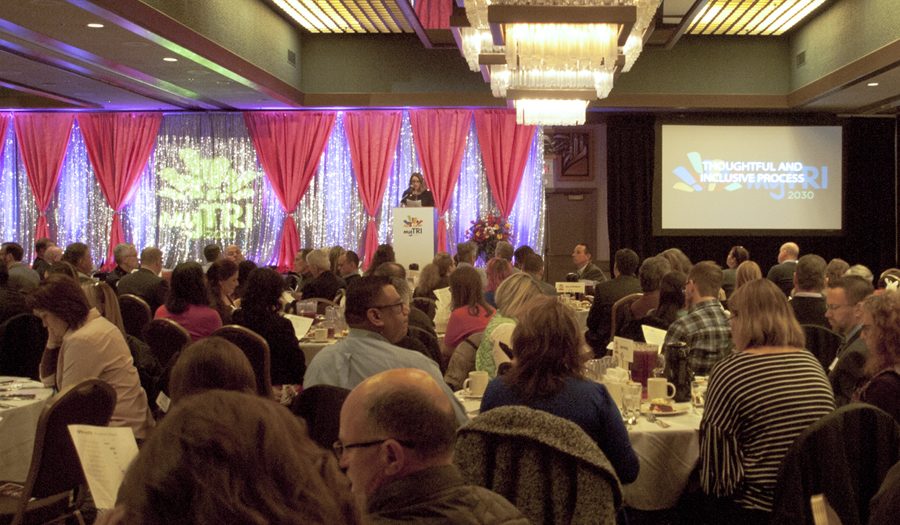
Home » Community visioning project MyTri2030 begins to take shape
Community visioning project MyTri2030 begins to take shape

March 13, 2019
Six key areas emerged when 4,500 Tri-Citians shared
their priorities for the region’s future.
The top focus areas — education, prosperity, inclusion,
agriculture, thriving life and energy — were unveiled last month after nearly a
year of working to better understand what citizens want to see develop in
Tri-Cities over the next decade.
Dubbed MyTri2030, the visioning project’s survey results
were unveiled Feb. 27 during a Tri-City Regional Chamber of Commerce luncheon
at the Pasco Red Lion Hotel and Convention Center.
Paula Linnen, chair of the Regional Affairs Committee,
said the MyTri2030 team noticed two central themes: immense pride in the
region’s achievements over the past decade and a noticeable fever from
community members and leaders to define new goals and opportunities for
regional collaboration.
“With a better understanding of our region’s strengths,
challenges and desires, the MyTri2030 team is proud to present a set of six
opportunity areas that will serve as a framework for the next phase of our
journey. It’s a journey we will continue to inform and implement together,”
Linnen said.
Here’s a closer look at the six big opportunity areas:
• Education: improving continuity between primary,
secondary and higher education, providing more resources for students and
encouraging them and their families to want to stay in the community.
• Prosperity: cultivating and promoting career
opportunities to link employer needs with talent already within the community,
including youths newly entering the workforce.
• Inclusion: drawing on the Tri-Cities’ uniquely diverse
population to unify the community via common values such as these six
opportunity areas to open the door to building more authentic connections
between community members.
• Agriculture: continuing to integrate the abundant
agricultural resources that first established the region into the economic and
social fabric of the region’s future and empower the growers who cultivate
them.
• Thriving life: overall enhancing the quality of life
of citizens, which will encourage them to want to remain a part of the Tri-City
community and continue to contribute to it and help it grow.
• Energy: capitalizing on the plethora of alternative
energy sources available in the region and drawing on the flourishing
technologic, scientific and higher education research communities to develop
those sources to build a firm foundation for an evolving energy future.
These opportunity areas were finalized after more than
100 hours of research, which included the review of successful community
visioning exercises conducted in similar communities across the country, as
well as past regional development reports, strategic plans and global and
national trends.
More than 4,500 responses were reviewed from the
bilingual, online survey launched last March. They were individually reviewed,
analyzed and discussed.
Following the survey period, one-on-one interviews were
conducted with about 30 community leaders by NewEdge Consulting, a
Richland-based firm that has assisted in the project, as it has with Fortune
500 companies across the nation who have reinvented themselves by identifying
specific opportunity areas to target for advancement.
After that, organizers convened a two-day “big vision
workshop” with more than 40 community stakeholders to specifically identify and
hone the opportunity list.
One big theme that seemed to underlie the six areas was
the desire to keep Tri-City youths in the community and attract more young
people and families to the area by improving and fine-tuning existing amenities
and infrastructure. As many of the community experts who spoke at the event
noted, if people can’t find what they need and want in their current community,
they will look for it elsewhere and eventually move on.
Linnen said about a quarter of the survey respondents
were youths, which emphasized the necessity of making this concern a
consideration in all action plans.
Rather than be intimidated by the task before them, the
Regional Affairs Committee has embraced the challenge of helping set in motion
what will shape Tri-Cities’ next 10 years and beyond.
“I love a big, hairy audacious goal,” Linnen said. “I
love something that is bold and compelling, that creates a little bit of
tension, a little bit of angst. Something that is big. Something that is
transformational. I think that it has motivated people around the world.”
Mike Schwenk, former chair of the Three Rivers Community
Roundtable, added that there are a lot of things that have occurred in our
community because we chose for them to occur.
Seeming to reinforce the words of these community
leaders, the event included a performance by Tri-City Youth Choir’s Forte!
group. They sang Pink’s “A Million Dreams,” from “The Greatest Showman” movie.
The
next step for MyTri2030?
“The
next phase is getting to a greater level of specificity,” Linnen said.
To
get there, the MyTri2030 project has reopened its survey, this time seeking
help from Tri-Citians to identify local people, organizations and projects
currently underway that fall under the six key opportunity areas.
“It
is critical that we get the right people in the room to decide, then prioritize
specific initiatives for the future,” said Stephanie Swanberg, government and
regional affairs director for the Tri-City Regional Chamber of Commerce.
The
online survey can be completed at mytri2030.com/survey and will be open for
about a month and a half.
Additionally,
those who couldn’t make it to the luncheon may attend one of three MyTri2030
public information sessions in March.
Here’s
the schedule:
•
March 16: 11 a.m. to noon at Mid-Columbia Libraries’ Pasco branch.
•
March 21: 7 to 8 p.m. at Mid-Columbia Libraries’ Keewaydin branch.
•
March 28: 7 to 8 p.m. at the Richland Public Library.
By
the end of 2019, the Regional Affairs Committee aims to have a final vision
plan fully outlined and ready to be share with the public.
MyTri2030 Regional Vision Project: mytri2030.com; Facebook.
Local News
KEYWORDS march 2019




